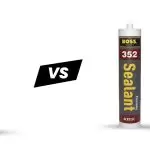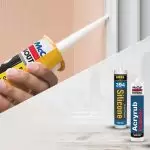Silicone sealants are versatile and indispensable in various construction applications, offering a protective barrier against water infiltration and sound transmission. In this comprehensive guide, we’ll delve into the different types of silicone sealants, their specific applications, and share valuable tips and tricks to achieve a professional finish every time. Additionally, we’ll explore the best practices for storing silicone sealants and the proper method for removing old sealant before replacement.
Post your Requirement
Types of Silicone Sealants
Choosing the right silicone sealant is crucial for various applications. Different types cater to specific needs, ensuring optimal performance in diverse conditions.
When dealing with high temperatures, it’s essential to invest in a silicone sealant designed to withstand the heat. High-temperature sealants, capable of resisting temperatures up to 600 degrees Fahrenheit, offer reliability in environments with extreme heat, shock, and vibration.
For electrical applications, opting for an electric-grade silicone sealant is key. These sealants lack corrosive substances, making them ideal for use in conditions exposed to moisture, sunlight, and weathering. Their ability to resist these elements ensures longevity and reliability for electrical components.
If versatility is the goal, a multipurpose silicone sealant proves to be a valuable choice. These sealants are resistant to extreme temperatures, moisture, weathering, and vibrations. Their compatibility with various surfaces such as ceramic, metal, wood, and glass makes them suitable for a wide range of projects.
Building with confidence becomes a reality when using these adhesives. Their ease of application, coupled with resistance to moisture, heat, and weathering, makes them invaluable across different industries. Whether you’re working on projects in your workplace or at home, having the right silicone sealant ensures durability and success.
At McCoy Mart, we offer top-notch silicone sealants from reputable brands like Boss, Dr. Fixit, McCoy Soudal, and Dowsil. These brands are synonymous with quality and reliability, ensuring that your structures are built to last. By choosing McCoy Mart, you gain access to a selection of the best products in the industry, providing you with the confidence needed to tackle any project.
Ordering from McCoy Mart means investing in the success of your construction endeavors. With our range of premium silicone sealants, you can be confident in the durability and longevity of your structures. Don’t compromise on quality when it comes to sealants—choose McCoy Mart for a seamless and reliable building experience.
Choosing the Right Silicone Sealant for the Job
Selecting the appropriate silicone sealant depends on the specific requirements of the project. Consider factors such as flexibility, adhesion, curing time, and the type of materials involved. Low modulus sealants are preferred for high-movement joints, while high modulus sealants are suitable for more rigid applications.
Tips and Tricks for a Perfect Finish
Here we have mentioned some of the tips and tricks for effective application of silicone sealants:
- Use Masking Tape: Achieving a clean finish with silicone sealant is simplified by using professional masking tape. Apply the tape on both sides of the sealing line, apply the sealant, and remove the tape before it dries. This technique ensures precise edges, similar to cutting when painting.
- Utilize Glass Cleaner: To smooth out silicone sealant seamlessly, consider using window cleaner. After applying the sealant, spray glass cleaner over it. The cleaner won’t mix with silicone, allowing for easy smoothing without sticking to unwanted surfaces. This method contributes to achieving a flawless finish.
Best Practices for Storing Silicone Sealant
Proper storage is crucial to maintain the quality of silicone sealants. Leave the nozzle attached, tightly screwed onto the cartridge thread, and squeeze out a small dab of sealant from the tip. This creates a plug that slows down further curing through the nozzle. When ready to use, pull on the hardened plug, and it should come out, leaving the nozzle ready for extrusion. If the plug breaks off or the sealant has cured further down the nozzle, unscrew it, clean with a piece of wire or a small screwdriver, reattach, and you’re ready to go again.
Removing Old Silicone Sealant
Before applying new sealant, it’s essential to remove the old one properly. Follow these steps:
- Apply Sealant Remover: Use a specialized sealant remover and let it sit for at least three hours.
- Scrape Away Sealant: Gently scrape away the silicone sealant using a robust plastic tool.
- Clean the Area: Wipe the area with a dry cloth to remove any remaining residue.
- Apply Rubbing Alcohol: To eliminate any stubborn residue, apply rubbing alcohol. It dries quickly, allowing you to proceed with sealing promptly.
Silicone sealants play a crucial role in construction, providing watertight seals and sound insulation. By understanding the different types of silicone sealants and their applications, choosing the right product for the job, and implementing professional tips and tricks, you can achieve a perfect finish every time.
FAQs
Q-1. What is silicone sealant used for?
A-1. Silicone Sealants are used to bond glass, ceramics, metals, plastic, concrete and bricks. They are also used in aerospace and engineering. Excellent for tile sealing, joint sealing and color grout sealing.
Q-2. Is silicone glue waterproof?
A-2. Yes, silicone is a multipurpose adhesive and sealant which creates a permanent waterproof, protective seal that is ideal for metal, glass, rubber, tile and porcelain.
Q-3. What is the use of sealant?
A-3. Sealant is a substance used to block the passage of fluids through openings in materials, a type of mechanical seal. In building construction sealant is sometimes synonymous with caulk (especially if acrylic latex or polyurethane based) and also serve the purposes of blocking dust, sound and heat transmission.





















Post A Comment